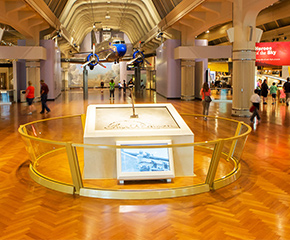Handbill for Wabash Railroad Company, "Only the Wabash Offers the Convenience of Delmar Station in St. Louis," Missouri, 1942
Add to SetSummary
The Wabash Railway, with origins dating back to 1838, was a strong Midwestern carrier until Amtrak took over the national passenger railroad system in 1971. During World War II, with automobile parts rationed and speed limits restricted, people returned to railroad travel in droves. In this handbill, the Wabash Railway promotes the conveniences of its Delmar Station. …
The Wabash Railway, with origins dating back to 1838, was a strong Midwestern carrier until Amtrak took over the national passenger railroad system in 1971. During World War II, with automobile parts rationed and speed limits restricted, people returned to railroad travel in droves. In this handbill, the Wabash Railway promotes the conveniences of its Delmar Station.
The Wabash Railway, with origins dating back to 1838, was a strong Midwestern carrier until Amtrak took over the national passenger railroad system in 1971.
By 1942, the Delmar Station had been a flagship station for the Wabash for 13 years. It continued to play a key role in the smooth and efficient operation of the company's lines in and out of St. Louis. After a long decline of passenger railroads, the increasing popularity of automobiles, the building of better roads, and general financial woes, railroads prospered during World War II. People returned to passenger railroad travel in droves, as gasoline, tires, batteries, and other products for maintaining automobiles and buses were all rationed, and the United States set a mandatory speed limit of 35 mph on highway driving. All of a sudden, it seemed that everyone was riding the rails again -- from private citizens to businessmen to soldiers and sailors. Scores of daily Wabash trains serviced passengers, and passenger mileage exceeded the previous record set in 1920 by almost double.
All major railroads were making profits by 1942, the date of this handbill. As usual, the Wabash promoted the Delmar Station's time-saving advantages, the novelty of boarding trains beforehand for midnight runs, and the convenience of its proximity to people's homes and workplaces. More overt than ever before is the appearance and mention of automobiles, including the reminder that boarding the train here eliminated traffic problems driving downtown and saved on tires as well. Ample parking was available at Delmar, a storage garage was located nearby, and a wide private driveway brought car-driven passengers to the main entrance of the station.
Artifact
Handbill
Date Made
1942
Subject Date
1942
Keywords
Collection Title
On Exhibit
By Request in the Benson Ford Research Center
Object ID
2012.67.9
Credit
From the Collections of The Henry Ford. Gift in Memory of John A. Barrett.
Material
Paper (Fiber product)
Color
Black-and-white (Colors)
Blue
Dimensions
Height: 3.25 in
Width: 5.875 in
Inscriptions
Text on front reads: Only the / Wabash Offers / THE CONVENIENCE OF / DELMAR STATION / IN ST. LOUIS Handwritten on front in ink: 1942 pARTIAL TEXT ON BACK READS: DO YOU KNOW THAT YOU MAY ENJOY THE / CONVNEIEMCE OF BOARDING OR LEAVING / YOUR TRAIN AT THE POPULAR, MODERN / EXCLUSIVELY WABASH DELMAR BOULEVARD / STATION...?





